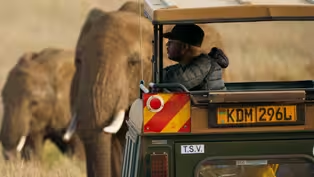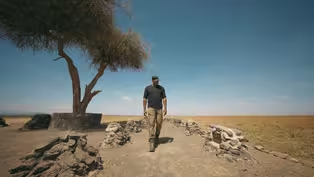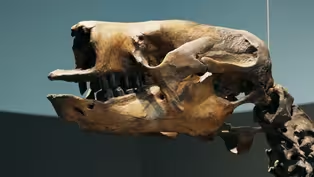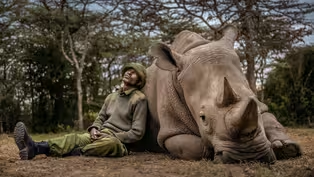
The Ghost Tree: Bringing Back the American Chestnut
Clip: Season 2 Episode 6 | 8m 15sVideo has Closed Captions
Sara Fitzsimmons fights to resurrect a tree that once ruled the eastern U.S. forests.
Billions of American chestnut trees once shaped life in Appalachia, but a foreign fungus erased them in a matter of decades. Today, only sickly sprouts remain — ghosts of a vanished ecosystem. Sara Fern Fitzsimmons and The American Chestnut Foundation are racing to breed resistance and restore the tree's ecological role. It’s slow, painstaking work — but it may hold the key to revival.
Problems playing video? | Closed Captioning Feedback
Problems playing video? | Closed Captioning Feedback

The Ghost Tree: Bringing Back the American Chestnut
Clip: Season 2 Episode 6 | 8m 15sVideo has Closed Captions
Billions of American chestnut trees once shaped life in Appalachia, but a foreign fungus erased them in a matter of decades. Today, only sickly sprouts remain — ghosts of a vanished ecosystem. Sara Fern Fitzsimmons and The American Chestnut Foundation are racing to breed resistance and restore the tree's ecological role. It’s slow, painstaking work — but it may hold the key to revival.
Problems playing video? | Closed Captioning Feedback
How to Watch Human Footprint
Human Footprint is available to stream on pbs.org and the free PBS App, available on iPhone, Apple TV, Android TV, Android smartphones, Amazon Fire TV, Amazon Fire Tablet, Roku, Samsung Smart TV, and Vizio.
Buy Now

Surprising Moments from Human Footprint
Do you think you know what it means to be human? In Human Footprint, Biologist Shane Campbell-Staton asks us all to think again. As he discovers, the story of our impact on the world around us is more complicated — and much more surprising — than you might realize.Providing Support for PBS.org
Learn Moreabout PBS online sponsorship(soft music) (Shane) Losing an abundant species can unravel the fabric of an ecosystem.
(percussive hip-hop music) ♪ (Sara) You always like it when you can’t get your arms all the way around it, right?
(assistant) I know, that’s a good sign.
(Sara) Beautiful.
(Shane) This is Sara Fern Fitzsimmons.
Her love of spreadsheets-- used for everything from planning family weekends to tracking her hikes-- is matched only by her passion for a tree whose ghost still haunts Eastern forests.
(Sara) The American Chestnut Foundation is a nonprofit organization dedicated to restoring the American chestnut back to its original range.
(serene music) (Shane) American chestnuts once numbered in the billions.
They sustained wildlife-- from deer to turkey, and black bears to passenger pigeons-- and they were the foundation for an entire subsistence culture in Appalachia (Sara) So, I grew up in southern West Virginia, and they called it a cradle-to-grave species because it could be used for cribs, coffins, and everything in between.
(Shane) But the American chestnut can’t do any of those things anymore.
The chestnut blight put an end to all that.
(Sara) The chestnut blight is a fungus.
Um, and it was brought over in the 1800s.
(Shane) The blight hitchhiked here on another chestnut species imported from Asia for landscaping.
And exactly what does the blight do to the tree?
(ripping sound) (Sara) The cambium tissue of a tree is its living layer; a fungal spore can get in, germinate in that tissue.
It completely strangles the tree by eating the tissue around it.
It’s pretty gruesome, actually.
(Shane) It sounds like a horror movie.
It really is.
(Shane) The fungus was discovered in 1904, and it spread fast.
(Sara) By 1950, pretty much the entire range from Maine to Georgia had become infected and all the big trees had--had succumbed.
(Shane) Today, the scale of that loss is hard to comprehend.
(Sara) It’s approximately 180 million acres.
And, in some locations, especially Southeastern Pennsylvania, some areas of Massachusetts and Virginia, it was as much as 50% of the forest.
(Shane) Today, some of those places are still covered in trees... but without the chestnut, it’s not the same forest.
No one alive remembers the forest that was.
Some of its parts remain, but the ecosystem is gone.
For the chestnut as a tree, it’s more complicated.
(Sara) So, the American chestnut is not technically extinct.
But, it’s functionally extinct.
There’s an estimated 400 million sprouts out there on the landscape.
(Shane) But Sara’s using the word "sprouts" in the same way that a zombie "sprouts" from its grave.
(Sara) So, this is a pretty classic oak-hickory forest type.
Back in the day, chestnuts would have covered this forest.
Here’s a perfect example of an American chestnut that has died back and then is sending up these new re-sprouts.
(Shane) This definitely isn’t a normal sapling.
(Sara) So, the roots are probably older than the blight.
(Shane) Because chestnut blight doesn’t attack the roots.
(Sara) So, this is still original genetics from when the blight first swept through.
It’ll die back, it’ll re-sprout.
This will continue forever, I imagine.
(Shane) It’s like a very sickly phoenix that keeps rising.
(Sara) There you go.
I like that.
-Okay.
-Yeah.
(birds chirping) (Shane) This little tree-- through a series of past lives, each cut tragically short-- might have been here longer than the blight has.
God, this is weird to look at.
The sprouts rarely get large enough to produce nuts because the blight is never far away.
(Sara) Even when the tree dies, the fungus is still around, just, you know, spewing spores into the, into the atmosphere.
(Shane) But that doesn’t mean the American chestnut is doomed.
Sara and her colleagues are trying to breed a better chestnut-- one that can hold its own against the blight.
(Sara) You say, "Well, this tree looks really good, it has really good resistance.
This tree looks really good, it has good resistance."
And then you have to put that together and see if you can build that up in the population.
(Shane) So, where can you find these genes for resistance?
One strategy is to look for the rare American chestnut that’s doing more than just sprouting and dying.
A new find in Central Pennsylvania might be the biggest chestnut tree in the state.
(Sara) There we go.
Ha ha!
Look at that.
That’s awesome.
(soft electronic music) So, these two are good and then that one’s, that one’s a dud.
(cameraman) That’s exciting.
It’s very exciting.
We grow the tree up, we take the fungus, we put it in the tree and we say, did it survive?
(Shane) It’s painstaking work, made possible by an army of volunteers.
♪ (man) .3, Sara.
(Shane) Another source of potential blight-resistant genes are Chinese chestnut trees, which evolved with the fungus and are naturally resistant.
Scientists are hybridizing the two species, trying to breed trees that are mostly American, but have the disease resistance of the Chinese species.
Some chestnut researchers are even using genome editing, although the exact genetic causes of resistance are still mostly unknown.
♪ The chestnut’s allies aren’t taking anything off the table.
(Sara) It’s not that it’s an American chestnut and it’s got, uh, you know, waving an American flag and has eagles flying over, you know, it’s not that which we are trying to, you know, restore into this tree.
It’s its ecological function.
Can it feed the insects?
Can it produce the nuts that all of our wildlife wants to eat?
(serene music) (Shane) Sara knows that American chestnuts won’t reclaim their former glory in her lifetime.
That kind of success could still be generations away.
But that doesn’t make her, or the chestnut’s other champions, any less devoted to the cause.
(Sara) In this world of instant gratification, I think having something that’s more of a slow movement, I think that that’s kind of refreshing.
(Shane) And it’s the least we can do for a species that’s fighting so hard to keep going.
Are there any American chestnuts that existed before the blight that are still, like, adult trees now?
(Sara) We think we know of about four that survived the original pandemic.
Four?
Oh, God.
(Sara) It’s not, so, from an estimated four billion, I mean, those aren’t great odds.
(gentle piano music) (Shane) But one of those one-in-a-billion trees-- surviving despite the fungus growing under its bark-- stood alone in a farmer’s field, not far away.
What are we all here for, if not to serve a function?
So, to be functionally extinct, to be around but serve no function... somehow seems sadder to me than just being gone.
♪ You think about forests that contained billions of these trees, and now this is one of a handful of this age.
♪ I mean, yeah, one of four.
♪ When chestnuts vanished from Eastern forests, a whole ecosystem was lost to human memory.
An interdependent web of life, built around a single "keystone" species.
Video has Closed Captions
Clip: S2 Ep6 | 5m 14s | Kenyan farmers and rangers balance danger and devotion in their fight to coexist with elephants. (5m 14s)
Video has Closed Captions
Preview: S2 Ep6 | 30s | Shane meets species on the brink of oblivion, and the people who won’t let them slip away. (30s)
Fossils in the Asphalt: Unearthing LA’s Ancient Past
Video has Closed Captions
Clip: S2 Ep6 | 3m 5s | At La Brea Tar Pits, Emily Lindsey digs into Ice Age life beneath LA’s surface. (3m 5s)
The Northern White Rhino Rescue Mission
Video has Closed Captions
Clip: S2 Ep6 | 11m 4s | Scientists fight to revive the northern white rhino — before it’s too late. (11m 4s)
Orca SOS: Sniffing Out Clues to Save the Southern Residents
Video has Closed Captions
Clip: S2 Ep6 | 3m 7s | Deborah Giles and her dog Eba track whale poop to help save endangered orcas. (3m 7s)
Providing Support for PBS.org
Learn Moreabout PBS online sponsorship
- Science and Nature

Explore scientific discoveries on television's most acclaimed science documentary series.

- Science and Nature

Capturing the splendor of the natural world, from the African plains to the Antarctic ice.












Support for PBS provided by:




